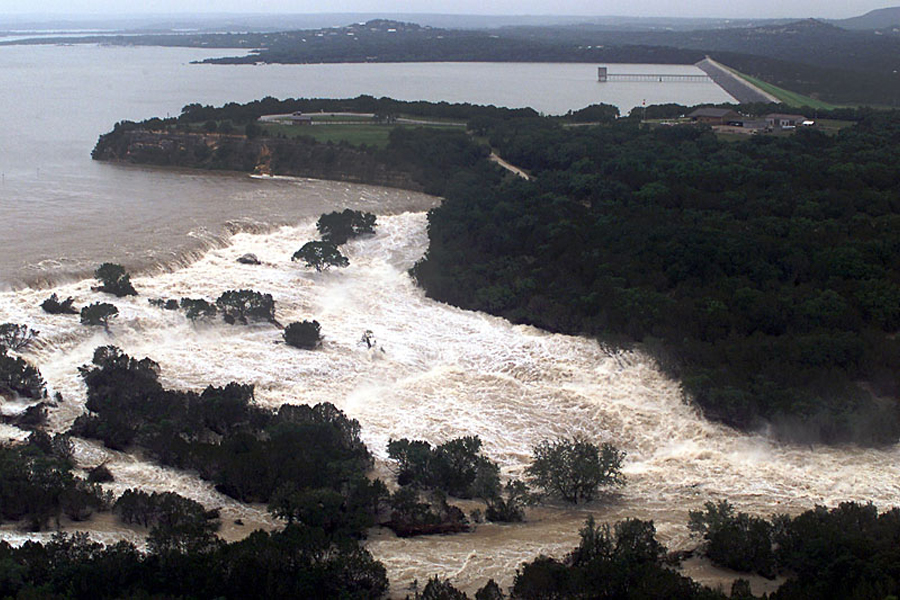
The number of dams in the United States at risk of overtopping is increasing, threatening their structural integrity and downstream communities, according to new research from the FAMU-FSU College of Engineering.

The study, published in Nature Communications, examined data from 33 dams over 50 years to determine how overtopping probability changed since 1973. The research found an increasing trend in the number of dams exhibiting critical overtopping probabilities (low, moderate and high) and a decline in the number of dams with non-critical overtopping probabilities (very low).
"Decades ago, dam builders used the best available technology knowledge, but things have been changing, so aging infrastructure is something that is a concern," said paper co-author Ebrahim Ahmadisharaf, an assistant professor in the FAMU-FSU College of Engineering and the Resilient Infrastructure and Disaster Response Center. "In this study, we showed where hazards from overtopping are greatest, both because of risk of occurrence and possible consequences. It is a guide to where infrastructure spending could have the greatest impact."
WHAT THEY DID
There are more than 90,000 dams of varying sizes in the country. The researchers narrowed their study to a smaller subset of about 130 sites that had at least 50 years of publicly available water level data. From this subset, they excluded dams influenced by upstream regulation or those with water level data lacking statistical independence. That left them with 33 sites for their study.
The team analyzed water level data from various dams and compared that information with the dam crest height. They examined every 30-year period within the larger 50 years of data to estimate how the probability of overtopping changed over time.
Of the 33 dams studied, 30 dams were classified as large, with crest heights greater than 15 meters, according to the criteria by the International Commission on Large Dams. Thirty-one dams were also classified as "high hazard" by the Federal Emergency Management Agency (FEMA), meaning their failure could result in loss of life.
The six dams with the highest probability and the closest downstream cities were located in Texas, Kansas and California:
- Canyon Dam: New Braunfels, Texas
- Kanopolis Dam: Marquette, Kansas
- Milford Dam: Junction, Kansas
- Somerville Dam: Somerville, Texas
- Whiskeytown Dam: Anderson, California
- Whitney Dam: Waco, Texas
"We have to plan upfront for this potential risk," Ahmadisharaf said. "This information can help dam managers to consider whether they need to revisit their emergency action plans and strategy for operating dams."
WHY IT MATTERS AND FUTURE DIRECTIONS
Overtopping occurs when stored water exceeds the capacity of a reservoir and spills over the top. This does not necessarily result in immediate damage or failure, but it weakens the dam structure and can increase the risk of catastrophic failure if it continues. Overtopping due to inadequate spillway design, debris blockage of spillways or settlement of the dam crest accounts for about 34% of all U.S. dam failures, according to the Association of State Dam Safety Officials.
Many U.S. dams were built nearly a century ago. Aging construction and changing hazards add to the risk for this crucial infrastructure. In its 2025 infrastructure report card, the American Society of Civil Engineers gave U.S. dams a D+ rating, underscoring the urgency of reassessment and modernization.
This study only considered water levels and dam height. Other factors that influence the likelihood of overtopping include spillway capacity, sedimentation buildup and the rate of inflow, but data for those components was unavailable. The article also focused on the overtopping probability but did not estimate potential consequences and risks. Future research that considers those elements would add to the study's rigor.
"This study represents the first step toward a comprehensive assessment of dam overtopping probabilities in the U.S. Understanding this potential risk is crucial for protecting communities and prioritizing dam rehabilitation before catastrophic failures occur," said co-author Eunsaem Cho, a former FSU postdoctoral researcher who is now a research associate at NASA Goddard Space Flight Center.






